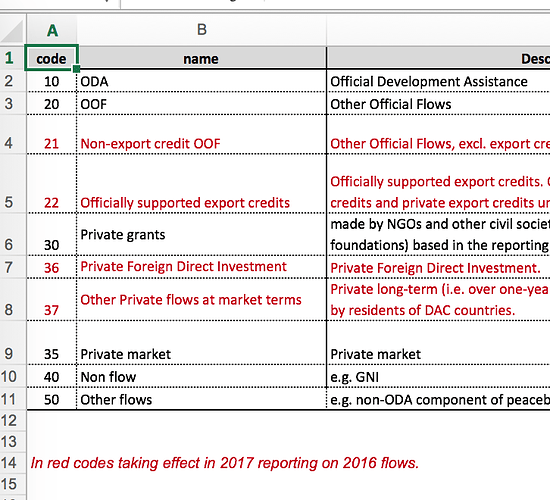I noticed that an update of the IATI Sector code list is upcoming, as the source list - the DAC CRS Purpose Codes - has been updated.
This is where I run into a slight difficulty. I can access six versions (in English) of this list, via the OECD website, at different URLs:
Via a page called DAC and CRS code lists:
- A spreadsheet “DAC and CRS list of codes (xls, July 2016)” - available at http://www.oecd.org/dac/stats/documentupload/DAC-CRS-Code-List.xls
- An XML file “DAC and CRS code lists in XML format based on IATI standard code list CLv1” at http://www.oecd.org/dac/stats/documentupload/DAC_codeLists.xml
And then, at “Purpose Codes: sector classification”:
- 2015 Purpose codes (PDF) - available at: http://www.oecd.org/dac/stats/documentupload/2015%20CRS%20purpose%20codes%20EN_updated%20April%202016.pdf
- 2016 Purpose codes (PDF) - available at: http://www.oecd.org/dac/stats/documentupload/CRS%20purpose%20codes%20-%202016%20flows%20updated%20April%202016.pdf
- Budget identifier voluntary purpose codes (PDF): http://www.oecd.org/dac/stats/documentupload/Budget%20identifier%20purpose%20codes_EN_Apr%202016.pdf
- Budget identifier voluntary purpose codes (xls): http://www.oecd.org/dac/stats/documentupload/Budget%20identifier%20purpose%20codes_Apr%202016.xls
I think these might be the same list, available in different formats (PDF, xls, XML), which could be acceptable. But, the XML version looks to be very out of date (last updated 2015-06-23T16:42:28), whilst the budget identifier voluntary codes do not appear on the 2015 or 2016 purpose codes PDF…
The fact that a) all these documents are at different URLs and b) there’s a lack of consistent or accessible changelog information are two reasons that slow me down when trying to answer the following:
- which list is definitive?
- when was it last updated?
- what was added in the last update?
It seems vital that where IATI relies on external code lists, people can ask these questions, and get some answers. For lists published via IATI, that seems to be the case. Is it reasonable to ask the same of DAC and CRS code lists?
NB: there’s a chance that I’m looking in the wrong place, or have missed a clarification document (which is a further issue), so please correct me if so



